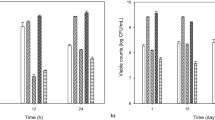Abstract
Probiotics have several beneficial effects on human health. Probiotic products available on the market today are usually dairy based and cannot be consumed by individuals who suffer lactose intolerance and allergies due to milk proteins. Fruits and vegetables offer healthy alternatives for the production of probiotic foods due to their large distribution and nutritive value. While searching for alternative food matrices, the suitability of bitter gourd (Momordica charantia), bottle gourd (Lagenaria siceraria) and carrot (Daucus carota) juice as a raw material taken for the production of probiotic drinks by lactic acid bacteria (Lactobacillus acidophilus NCDC 11, Lactobacillus plantarum NCDC 414, Pediococcus pantosaceus MTCC 2819) was investigated. The vegetable juice was fermented at 30°C for up to 72 h and changes in the microbial population, pH, sugars and titrable acidity were observed during the fermentation period. The viable cell counts reached up to 8 log CFU/ml, from an initial count of 6 log cfu/ml, and pH decreased from an initial value of 5.2 to below 3.5. The viability of all strains was also determined during the storage time at 4°C within 4 weeks. The viable cell counts of the lactic cultures in the fermented vegetable juice gradually decreased during cold storage. The vegetable juice proved to be a suitable media for the production of a fermented probiotic drink and can serve as a healthy beverage for vegetarians, particularly diabetics.
Similar content being viewed by others
References
Aureli P, Capurso L, Castellazzi AM et al (2011) Probiotics and health: an evidence-based review. Pharmacol Res 63:366–376
Luckow T, Delahunty C (2004) Which juice is ‘healthier’? A consumer study of probiotic non-dairy juice drinks. Food Qual Prefer 15:751–759
Karovicova J, Kohajdova Z (2003) Lactic acid fermented vegetable juices. Hort Sci (Prague) 30:152–158
Kalliomaki M, Salminen S, Arvilommi H et al (2001) Probiotics in primary prevention of atopic disease: a randomized placebo controlled trial. Lancet 357:1076–1079
Betoret N, Puente L, Diaz MJ et al (2003) Development of probiotic enriched dried fruits by vacuum impregnation. J Food Eng 56:273–277
Sheehan VM, Ross P, Fitzgerald GF (2007) Assessing the acid tolerance and the technological robustness of probiotic cultures for fortification in fruit juices. Innov Food Sci Emerg Technol 8:279–284
El Batran SAES, El Genghaihi SE, El Shabrawy OA (2006) Some toxicological studies of Momordica charantia L. on albino rats in normal and alloxan diabetic rats. J Ethnopharmacol 108:236–242
Grover JK, Yadav S, Vats V (2002) Medicinal plants of India with anti-diabetic potential. J Ethnopharmacol 81:81–100
Santos MCR (2001) Desenvolvimento de bebida e farinha láctea fermentada de acao probiótica a base de soro de leite e farinha de mandioca por cultura mista de Lactobacillus plantarum A6, Lactobacillus casei Shirota e Lactobacillus acidophilus. MSc thesis. UFPR, 106–154
Yoon KY, Woodams EE, Hang YD (2004) Probiotication of tomato juice by lactic acid bacteria. J Microbiol 42:315–318
Yoon KY, Woodams EE, Hang YD (2006) Production of probiotic cabbage juice by lactic acid bacteria. Bioresource Technol 97:1427–1430
Yoon KY, Woodams EE, Hang YD (2005) Fermentation of beet juice by beneficial lactic acid bacteria. Lebensm Wiss Technol 38:73–75
Mousavi ZE, Mousavi SM, Razavi SH et al (2011) Fermentation of pomegranate juice by probiotic lactic acid bacteria. World J Microb Biot 27:123–128
Pereira ALF, Maciel TC, Rodrigues S (2010) Probiotic beverage from cashew apple juice fermented with Lactobacillus casei. Food Res Int 44:1276–1283
Khurana HK, Kanawajia SK (2007) Recent trends in development of fermented milks. Curr Nutr Food Sci 3:91–108
Charernjiratrakul W, Kantachote D, Vuddhakul V (2007) Probiotic lactic acid bacteria for applications in vegetarian food products. Songklanakarin J Sci Technol 29:981–991
Author information
Authors and Affiliations
Corresponding author
Rights and permissions
About this article
Cite this article
Sharma, V., Mishra, H.N. Fermentation of vegetable juice mixture by probiotic lactic acid bacteria. Nutrafoods 12, 17–22 (2013). https://doi.org/10.1007/s13749-012-0050-y
Received:
Accepted:
Published:
Issue Date:
DOI: https://doi.org/10.1007/s13749-012-0050-y




